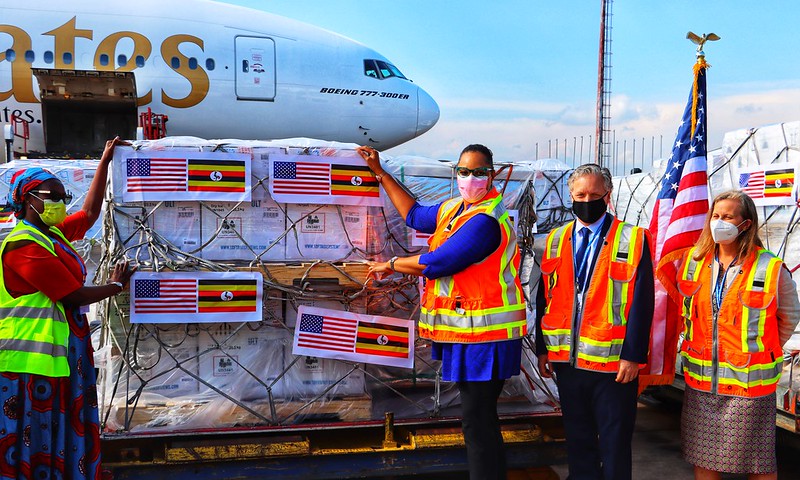COVID-19’s Impact on Uganda

With more than 126,000 cumulative cases overall, the coronavirus is spreading fast through Uganda. As a result, the East African country is exhausting its health and safety resources, impacting the livelihood of its people. However, hope may be on the horizon thanks to the U.S. embassy. One of its newest missions invites a roster of vendors to supply high-quality medical equipment to Kampala, the Ugandan capital, as a means of alleviating COVID-19’s impact on Uganda.
The Way COVID-19 Intensified Poverty in Uganda
An international psychogeriatric study interviewed dozens of older Ugandan adults in an effort to capture their post-COVID-19 struggles. Its analysis describes five overarching themes: economic impacts, lack of access to basic necessities, impact on health care utilization, social impacts and violent reinforcement of public health restrictions.
During the pandemic’s first eight weeks, 1.9 million Ugandans fell into poverty, increasing that rate by nearly 16%. Some would resort to self-started businesses in times of economic hardship, but this is no longer an option for many Ugandans due to heavy health restrictions.
“I used to work for myself,” one 82-year-old Ugandan told researchers backed by the University of Liverpool and the National Institute for Health Research Applied Research Collaboration North West Coast in December 2020.
“I could eat and drink because I used to make roasted g-nuts and I sell them in this area. But when (the coronavirus) came, there is no moving. People have no money.”
An estimated 60% of informal business owners lost their livelihoods in the first eight weeks of the pandemic, all while the overall unemployment rate in Uganda increased from 1.8% in 2019 to 2.4% in 2020.
The inability of older Ugandans to commute or work because of the heavy health regulations and curfews is pushing younger generations to stay home and take care of their elders. Many of the older adults participating in the Liverpool study stated they were no longer able to pay their grandchildren’s school fees.
Some 15 million Ugandan learners — and 600,000 refugee learners — are currently out of school, according to the country’s education ministry. Since learning serves as a ticket out of poverty for many Ugandan youth, poor access to that and health care have resulted in children possibly lacking vital elements to construct any sort of livable circumstance.
A Struggling Health Care System
Uganda has a dozen post-graduate medical colleges and 29 nursing schools. Even so, there remains a shortage of health care workers and tools.
One of COVID-19’s impacts on Uganda is that it is experiencing an influx of patients. As a result, Ugandan doctors have been turning to Indian laboratories, sending patients abroad and violating health and travel restrictions. Ugandan health experts assert that poor government investments in health care are the reason for hospital inadequacies. For example, the medical sector represented only 5% of national spending in Uganda during the first full fiscal year of the pandemic compared with about 8% the year before. That decrease is due to a 90% decline in on-budget external financing for health care—from $332 million to just under $28 million.
The deadly mix of COVID-19 and economic instability has left an impact via a “domino effect” of multiple large-scale problems. Wealthier countries with greater ability to mitigate the virus can salvage key economic sectors like income, transportation and other aspects of poverty. Thus, a crucial step in relieving the medley of issues Uganda is experiencing may be to address the root of it all — the coronavirus. This could lead to the lifting of public health restrictions, allowing businesses to recover. The first step in this direction could involve making health care more accessible.
New Tools for Ugandan Health Care
The embassy issued equipment and supply requests at the beginning of November 2021 to alleviate COVID-19’s impact on Uganda, allowing U.S. companies to bid on and deliver easy-to-use, cutting-edge items ranging from integrated wall systems — that include vital equipment like blood pressure cuffs, devices that check ears and thermometers — to laryngoscopes, which can examine a patient’s larynx. Just days after these requests, Uganda mission director Richard Nelson kickstarted the process by donating more than $2 million worth of safety necessities.
Another useful procurement is COVAX, a global initiative working to supply vaccines. COVAX raised more than $2 billion, ultimately distributing some 700 million vaccine doses worldwide. However, Uganda only administered eight vaccines shots for every 100 people as of April 2021. With COVAX, Uganda is guaranteed 3 million new doses by spring, already collecting some 196,000 doses of the Johnson & Johnson vaccine in October 2021.
However, this is not enough to ensure herd immunity — what public health experts say could be necessary to stop the spread of the coronavirus overall. To seal such gaps, 49 countries and 51 organizations are donating to COVAX, with the Bill and Melinda Gates Foundation pledging more than $200 million. TikTok, Google and the Coca-Cola Co. are some of the other significant names making donations. A German business delegation that H.E. Matthias Schauer led said it was directly donating 5.5 million new Johnson & Johnson vaccine doses in early November 2021.
COVID-19 has deeply impacted Ugandan businesses and stripped the livelihoods of young and old alike. However, the U.S. is helping reduce COVID-19’s impact on Uganda through a foreign aid program, especially as the pandemic’s mortality rate continues to grow.
– Fidelia Gavrilenko
Photo: Flickr
